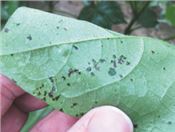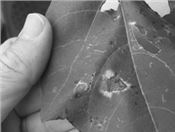|
Specialists Give Cotton Disease Update

Symptoms associated with bacterial blight are easiest to observe on the underside
of the leaf as a result of the water-soaking.
DR. TOM ALLEN & DR. DARRIN DODDS
MISSISSIPPI STATE, MISS.
Once again, cotton fields have been observed to contain bacterial blight. The recent environmental conditions with cooler than average temperatures and increased rainfall throughout much of the state have contributed to the level of infection to this point in the season. As of Wednesday afternoon (July 5, 2017), bacterial blight had been confirmed on five varieties (see to right) and observed in 10 counties.
Counties with observed bacterial blight:
Bolivar, Carroll, Coahoma, Leflore, Noxubee, Sunflower, Tallahatchie, Tunica, Washington, and Yazoo
Varieties observed to be infected with bacterial blight (however, the list of varieties may change given that some consultants are checking varieties with farmers):
DPL 1522 B2RF
DPL 1555 B2RF
DPL 1725 B2XF
PHY 333 WRF
PHY 499 WRF
Scouting for bacterial blight can be difficult. Herbicide injury as either drift or from a direct application can easily complicate the symptoms associated with bacterial blight. Scouting cotton in the morning, when dew is still present makes observing symptoms a little easier. The lesions associated with bacterial blight are generally best observed on the underside of the leaf. In general, the lesions associated with bacterial blight are angular and remain between the veins on the cotton leaf. Leaf-associated lesions can also follow veins as most often occurs with systemic infections by the bacterium. Lesions associated with the disease can also be observed on bracts and petioles. When bolls are present, bacterial blight can be observed on bolls; however, the lesions are not angular and develop a round appearance.
Management options once cotton is infected with bacterial blight do not exist. With that in mind, do not change the overall management strategy for the 2017 season. Over the past several years bacterial blight has been observed in some cotton fields at specific growth stages and was not observed once the crop began to set bolls.
Target spot
As of this morning, July 6, target spot has not been observed in the MS cotton crop. However, be mindful that several things can appear quite similar to target spot. This season in particular lesions associated with bacterial blight have in some rare instances been observed to produce a bright yellow halo around bacterial blight lesions with what appears to be concentric lesions. Instances similar to the photo provided, where bacterial blight appears similar to target spot, may be associated with secondary infection. However, numerous other states have recently reported similar lesion types associated with bacterial blight. Observe multiple leaves and remember that target spot normally does not occur until the canopy closes. In addition, be mindful that target spot does not begin in the upper canopy. Target spot lesions begin in the lower canopy and if environmental conditions are conducive for extended periods of time (generally as a result of overcast, warm, humid conditions that can be exacerbated by extended periods of wet foliage). Be mindful that target spot does not start until the canopy closes and begins in the bottom of the canopy, but requires a conducive environment to cause defoliation and move into the upper canopy. ∆
DR. TOM ALLEN: Extension Plant Pathologist, Mississippi State University
DR. DARRIN DODDS: Extension Cotton Specialist, Mississippi State University

Bacterial blight, in rare instances, can result in lesions that mimic target spot.
Be careful jumping to conclusions, scout fields thoroughly.
|
|